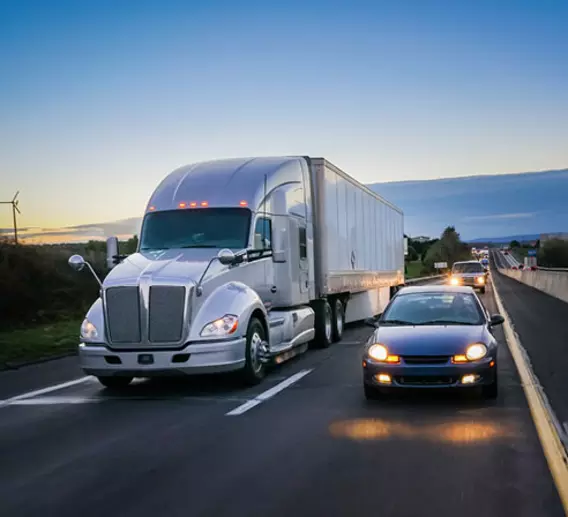Why safe driving matters
As a leading logistics provider, ArcBest® knows that safe, reliable transportation is critical to shippers and carriers. And while truck drivers work hard to ensure that every shipment arrives at its destination without any issues, we all play a role in keeping our roadways safe and accident-free. Practicing good road awareness is one of the best ways to prevent problems on the road and show appreciation for the critical role truck drivers play in our country.
Tips for safely sharing the road with big trucks
Use these six safety tips to help everyone arrive safely at their destinations:
1. Drive predictably
Because of their size, trucks require more time and distance to slow down, stop and turn than passenger vehicles. That’s why it’s important to avoid sudden movements and signal any changes you’re going to make. When driving around semis, be sure to:
-
Maintain a consistent speed
-
Signal well in advance
-
Avoid rapid or frequent lane changes
-
Double check your blind spots
-
Plan ahead for exits
2. Keep a safe distance
When following behind a semi, the Federal Motor Carrier Safety Administration recommends leaving 4 seconds between you and a commercial vehicle if driving under 40 mph and adding another second if going over 40 mph. Double the safe following distance if road conditions aren’t ideal due to visibility, traffic or weather.
3. Know where the blind spots are (and try to avoid them)
A good rule of thumb is this: if you can’t see the driver in their mirrors, then the driver can’t see you. If you must pass through a blind spot, do so quickly and don’t remain there long.
Learn more about common blind spots on semis:
Right behind the truck
The driver’s mirrors can’t reflect activity right behind the trailer. When driving directly behind the truck, the driver can’t see you, and you may not have time to react if they brake or swerve. Driving in this spot is often called “drafting” because it theoretically reduces drag, but it is a hazardous practice that should be avoided.
Directly in front
The long hood can hide sightlines at least 20 feet in front of the vehicle. And since trucks need more space to slow down and stop, driving closely in front of a truck can be dangerous. Even if the driver can see you, they will need that extra room to maneuver the large truck safely.
Left side
Even though the driver sits on this side, the angle of the mirrors can block drivers from clearly seeing approaching vehicles one lane over, extending three-quarters of the way to the back.
Right side
The blind spot on the right covers more area, stretching across two lanes and past the rear of the trailer. It’s best to avoid passing on the right.
4. Watch for light signals
While truck drivers may communicate with each other over the radio, they often use their lights to communicate with cars. These cues can indicate many things:
-
Two quick flashes. If you’re trying to merge in front of a truck, they may flash their lights to signal that they are allowing a safe lane change. This signal can also serve as a “thank you” for letting them merge.
-
Several quick flashes. If a truck driver flashes their lights several times when driving past, they are likely warning of an upcoming danger, like an accident or debris on the road.
-
Hazard lights. Blinking hazard lights can mean several different things. First, a driver may use them if they see an upcoming slowdown or to warn about sudden braking. The use of hazards may also indicate that a truck is driving slower than the speed limit, often due to a heavy load in hilly or mountainous terrain.
5. Stay focused
While many states have laws prohibiting cell phone use while driving, many other things can cause distractions like eating, drinking, and tending to pets or children. Avoid these activities to keep everyone safe on the road.
6. Use care when merging
Trying to stand your ground and not let trucks merge is not just inconsiderate; it’s potentially dangerous. When merging onto a highway, try and gauge speeds to safely move between trucks in motion. If a truck is coming up an on-ramp, slow down or move to the left lane to give plenty of room for them to join the flow of traffic.
How ArcBest makes safety a priority on the road
At ArcBest, we’re committed to safety at our campuses and on the road. We equip our drivers with training and tools to help them maintain high safety standards and protocols. We reward drivers when they reach safe driving milestones, like consecutive hours or miles without a preventable accident. Find out how many drivers went accident-free over one million miles or 5,000 hours in our annual ESG report.

